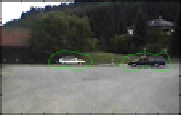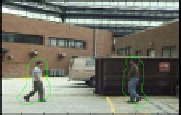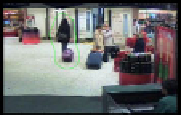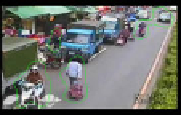Information Technology Reference
In-Depth Information
3.3 Supported Video Surveillance Events
Until now, our system supports the following 5 events:
-
C1: Approaching vehicule to the camera (figure 4.a)
-
C2: One or more moving vehicule (figure 4.b)
-
C3: Approaching pedestrian (figure 4.c)
-
C4: One or more moving pedestrian (figure 4.d)
-
C5: Combinated Concept (figure 4.e)
(a)
(b)
(c)
(d)
(e)
Fig. 4.
Examples of images extracted from our video surveillance dataset
4 Combining Single SVM Classifier for Learning Video
Event
Support Vector Machines (SVMs) have been applied successfully to solve many
problems of classification and regression. However, SVMs suffer from a phenomenon
called 'catastrophic forgetting', which involves loss of information learned in the
presence of new training data. Learn++ [14] has recently been introduced as an in-
cremental learning algorithm. The strength of Learn++ is its ability to learn new
data without forgetting prior knowledge and without requiring access to any data
already seen, even if new data introduce new classes. To benefit from the speed of
SVMs and the ability of incremental learning of Learn++, we propose to use a set of
trained classifiers with SVMs based on Learn++ inspired from [13]. Experimental
results of detection of events suggest that the proposed combination is promising.
According to the data, the performance of SVMs is similar or even superior to that
of a neural network or a Gaussian mixture model.
4.1 SVM Classifier
Support Vector Machines (SVMs) are a set of supervised learning techniques to
solve problems of discrimination and regression. The SVM is a generalization of
linear classifiers.The SVMs have been applied to many fields (bio-informatics,
information retrieval, computer vision, finance ...).






Search WWH ::

Custom Search